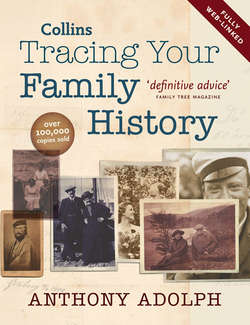Читать книгу Collins Tracing Your Family History - Ryan Tubridy, Anthony Adolph - Страница 123
1851–1901 CENSUSES
ОглавлениеThese are broadly similar in their detail and survive almost complete. They give:
Address. As 1841. In 1891 and 1901, the number of rooms occupied, if less than five, was recorded. Double dashes indicate the break between buildings; single dashes indicate the break between different households in the same building.
Name of each person in the household. Initials of middle names could be and often were recorded.
Relationship to the head of household. Usually wife, son or daughter, but also step-child, in-laws, servants and, if you are very lucky, parents or grandparents. Sometimes the terms ‘in-law’ and ‘step-’ were used differently to nowadays: a son-in-law today means the daughter’s husband, but then it was sometimes used for the wife’s son by a previous marriage, what we would now term a ‘step-son’, and vice versa.
Marital condition. Married, single or widowed.
Age. Ages were recorded precisely.
Occupation. In 1891 and 1901, the census notes whether the person was an employee or employer and, if the latter, how many people, if any, they employed. The acreage of farms was also noted.
If working at home. This was a new column added in 1901.
Place of birth. Recorded by parish and county. If the person was born outside England and Wales, usually only the country would be given, although sometimes you may be lucky and find the parish or nearby town stated too. If luck does not strike with the first census return you examine, try another.
Physical and mental condition. This was a column for those who were blind, deaf and dumb. Further categories, ‘imbecile or idiot; lunatic’ were added in 1871, subsequently changed to ‘lunatic, imbecile, feeble-minded’ in 1901.
